This is a Eumigetta, a collapsible lens medium format camera made by Eumig in Vienna, Austria between the years 1951 and 1954. The Eumigetta shoots 6cm x 6cm images on 120 format roll film and has a full focusing lens, adjustable diaphragm, and a single speed shutter. A more advanced model called the Eumigetta II was also released, which upgraded the lens to a faster f/4.5 design and added multiple shutter speeds. Although a simple camera with limited features, the Eumigetta has good build quality and proved to be a capable camera. As one of the few Austrian camera being made in the 1950s, it was an affordable alternative to more expensive German cameras.
Film Type: 120 Roll Film (twelve 6cm x 6cm exposures per roll)
Lens: 8cm f/5.6 Eumig Eumar coated 3-elements
Focus: 1 meter to Infinity
Viewfinder: Scale Focus Viewfinder
Shutter: Metal Blade
Speeds: Single Speed ~1/50
Exposure Meter: None
Battery: None
Flash Mount: None
Weight: 534 grams
Manual: None
The name “Eumig” likely won’t resonate with many collectors today as it was a small Austrian company with a very short list of cameras made over a very short period of time. Eumig is an acronym for Elektrizitäts und Metallwaren Industrie Gesellschaft which translates in English to Electricity and Metal Goods Industry Company.
Eumig was formed in 1919 by Karl Vockenhuber, Alois Handler and Adolf Halpern to produce cigarette lighters and other small electrical devices. In 1924, the company produced its first consumer radio, an economically priced model called the Eumig Baby. Many of Eumig’s early radios used Bakelite in their construction, following a similar pattern to the American company International Radio Corporation, who would later become Argus. Like IRC, Eumig would eventually jump into the world of photography with a film projector, and eventually inexpensive motion picture cameras. The company’s first big successes were motion picture cameras for 9.5mm film called the Eumig C-series, which an estimated 300,000 were produced.
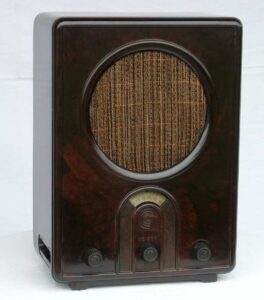
A piece of Eumig’s unfortunate history was a radio the company made called the Eumig VE301 which had the nickname “Volksempfänger” or “People’s Receiver” in English, which was commissioned by Joseph Goebbels, the Reich Minister of Propaganda for Nazi Germany. Production of the Volksempfänger was intended to put a radio in the homes of as many German citizens as possible to help spread Nazi propaganda by the government. At a cost of 76 RM which was roughly equal to 2 weeks salary of the average German worker, a large number of these radios became a familiar sight in the homes of many German families in the mid to late 1930s.
Eumig continued to produce radios and other electronic products through the war, but its Buchengasse factory in Vienna was destroyed by Allied forces in 1945. The company would regroup and around 1950 resume radio manufacturing, something they would continue to do until 1962.
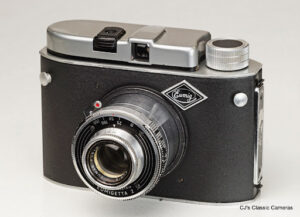
In 1951, the company would produce its first still film camera the Eumigetta, a rigid body collapsible lens 6cm x 6cm medium format camera. The Eumigetta had an all metal body, covered in a black crinkle paint finish and had a simple single speed metal blade shutter and an 8cm f/5.6 lens. While I could find no information regarding the makeup of this lens, I initially thought perhaps it was a doublet, but that doublets rarely open wider than f/8, I revised my prediction to this being a triplet.
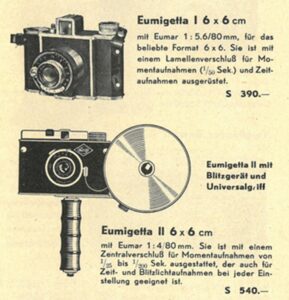
The Eumigetta was a well built, but inexpensive camera that was not exported to western countries. In 1953, an updated camera called the Eumigetta II was released with a faster f/4.5 lens, an optical viewfinder, and a four speed shutter with speeds 1/25 to 1/200 plus Bulb. The Eumigetta II was produced until 1954, after which an estimated 8000 of the original Eumigettas were produced and 16,000 of the second model. I could find no English language advertisements for either camera online so it can be assumed based on the simple construction of the cameras, plus Eumig’s reputation as a maker of affordable radios and other products, the cost of ownership was probably low.
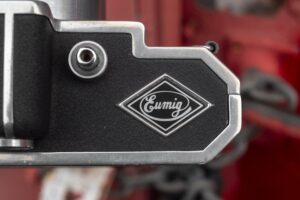
This Eumigetta came to me from the collection of Kurt Ingham, and is one of many uncommon cameras I had never heard of before I saw it. While I have a large number of roll film cameras capable of shooting 6cm x 6cm images, I was drawn to the Eumigetta’s unique metal body and collapsible lens. Having previously shot another simple collapsible lens 6×6 camera, the Pouva Start, I was intrigued by this model and wanted to learn more about it.
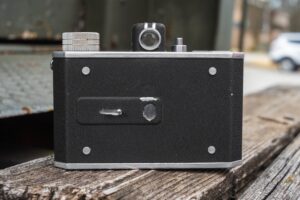
The Eumigetta has a good feel in your hands and does not feel cheaply built, even though its modest specifications suggest otherwise. In fact, for such a cheap camera, it has a couple thoughtful features like a spring loaded door to cover the red exposure window, elongated strap lugs which rotate, a cable threaded shutter release, an all glass viewfinder, and a safety feature which prevents the shutter from accidentally firing when the lens is not fully extended. Certainly none of these features were unique to this camera, but are those who aren’t always found on entry level cameras.

The crinkle paint finish has a nice matte finish which also helps increase grip on the camera, making it less slippery than a Bakelite body would have been, and the contrast between it and the exposed metal edges and two vertical stripes going across the viewfinder hump add a bit of elegance to the camera.
Up top, the camera starts with the film advance lever on the left, followed the viewfinder hump with two vertical stripes on it. Next is the cable threaded shutter release, which is a nice surprise for a camera in this class. Finally, we are treated to an elegant diamond shaped Eumig logo plate that serves no purpose other than it looks pretty!
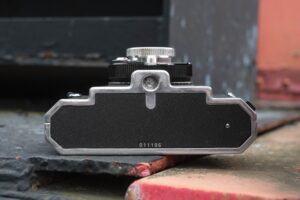
The base of the camera mimics the shape of the top plate but only features a centrally located 3/8″ tripod socket. The location of the socket means that the camera would be well balanced on a tripod for long exposures. The use of a 3/8″ rather than a 1/4″ tripod socket was common for European cameras of this era and would require an adapter if someone wanted to shoot this camera with a modern tripod.

Loading film is done by sliding the door latch on the camera’s left side. The design of this latch has two metal posts that slide through angled channels, which when closing, cause the posts to pull the door into the body, providing a night, light tight seal. In addition to light protection, the tight seal provides additional protection from the door being accidentally opened. With the latch open, the entire door removes to reveal an ordinary roll film compartment with a few nice surprises.
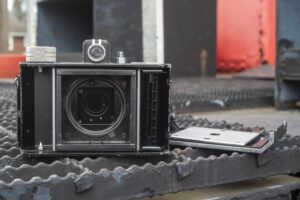
Film transports from right to left on standard 120 spools. A hinged bracket on the supply side swings out to make loading in a new roll of film really easy. Chrome rollers on both sides of the film gate and a large polished metal pressure plate help ensure smooth and flat film across the plane. The pressure plate is unpainted metal, which can have the negative consequence of reflecting light back from the lens onto the rear of the film when shooting slide film, so that should be avoided. The inclusion of a hinged bracket, chrome rollers, and polished metal pressure plate are all things not always found on cheap cameras, and suggest a more upscale camera.
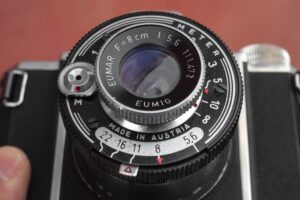
The lens and shutter extend easily and can be twisted to lock it into position, preventing unintended collapsing while shooting. All exposure control is on the front. The Eumigetta has only a single shutter speed of about 1/50 indicated by the letter “M”, but using a metal dial to the left of the lens, it can be rotated to a “Bulb” position for long exposures. This is where the cable threaded shutter release and a 3/8″ tripod socket on the base of the camera would come in handy. The diaphragm is controlled by a lever offering f/stops of f/5.6 to f/22. The f/8 position is indicated with a red dot, which when matched up to a red arrow on the focus scale just beyond the 5 meter mark is where you can set to use the camera for snapshots. In this position, the 8cm lens has a depth of field from 4.5m to 9m and a hyperfocal distance of 17.5 meters.

The viewfinder is a straight through optical design, but is quite large, especially for a camera from this era. I had no issues seeing all four corners while wearing prescription glasses which made composition easy.
It is clear that unlike other entry level cameras, Eumig made the best camera could. In fact, this might be the best cheap camera I’ve ever handled. Its combination of high build quality and a surprising combination of features allowed this camera to jump many spots in my “to shoot queue”, demanding I give it a look sooner, rather than later.
For my first roll in the Eumigetta, I loaded in a roll of film I had recently purchased which I was excited to try, Rollei RPX 25 120. I have shot this stock before in 35mm, but just because a film stock is available in both 120 and 35mm, doesn’t always guarantee that the two films will behave the same. In 35mm, I found RPX 25 to have extremely fine grain but very high contrast. In some instances, I found that some images could have blown out whites and muddy blacks in the same image. Whenever you increase the size of a negative, you not only increase detail, but sometimes things like contrast can change, so I was eager to see how it would turn out in this camera. Plus, slower speed films are usually a better match for cameras like the Eumigetta with single shutter speeds.
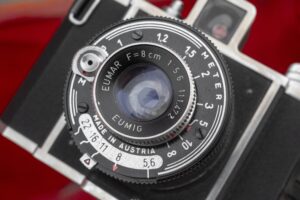
The results from the Eumigetta were very impressive and way better than I had expected. There were a huge number of inexpensive 6×6 roll film cameras produced in the mid 20th century, all with quality ranging from “not bad” to complete garbage. Despite a modest f/5.6 maximum aperture, the Eumig Eumar lens produced images with excellent sharpness and contrast in nearly every scene I shot it in.
Although very good, the images were not perfect as I did notice a bit of haze in a few images with where bright skies were present such as the sidewalk scene with the tables and chairs. I inspected the lens with the shutter open and saw no such haze, so most likely, this haze is the result of light bouncing around inside the lens. Sharpness near the edges does drop off and some vignetting was visible, but each of these anomalies were all kept to a minimum and on par with that of more advanced cameras such as Rolleicords and simpler Yashica TLRs.
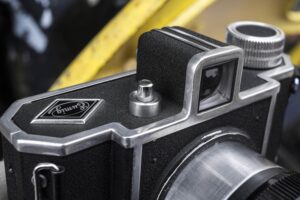
When I first saw this camera, I wasn’t particularly excited, but as I got to handling it and actually shooting it with film, I became more and more impressed. The overall workmanship of the camera is very good. I liked the textured crinkle paint finish which gave the camera a good amount of grip. The metal borders and two stripes across the viewfinder hump give the camera an unexpected level of elegance. The film advance lever is sturdy and moves without any play. Focusing the lens is nicely dampened and the aperture control is as smooth as cameras costing significantly more. The viewfinder is very large and easy to use, even with prescription glasses, and of course, the images from the lens are quite nice.
In addition to the normal things you’d expect to read about in a camera review, the Eumigetta has a number of small surprises which you probably wouldn’t expect to see in a camera of this class. The top plate shutter release is better than those from some higher spec cameras, I appreciated the spring loaded door that covers the red exposure window, the film door latch is well designed and prevents it from accidentally opening, and the hinged bracket in the film compartment makes changing film a lot easier than some other roll film cameras.
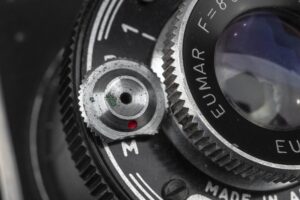
It is usually pretty difficult to come up with complaints for basic cameras as the bar is usually pretty low, but even if I were to raise the bar for this camera, I still don’t have any major complaints. It is clear that whoever designed this camera put a lot of effort into making the best camera they could with a modest budget in mind. This could very well be the best cheapest 6×6 medium format camera I’ve ever used.
Eumig did make a follow-up to this camera called the Eumigetta II which has a faster lens, a four speed shutter, and a revised body, and while each of those upgrades are worthy additions, the original model is quite good on its own. If I were a completist, I would probably seek out the later model to add to my collection, but as a user, I see no reason to upgrade as the earlier Eumigetta is a very good camera that’s fun and easy to use and produces nice results.
This is not a common camera and is probably quite difficult to find in Western countries, but if one ever does cross your path, I definitely recommend checking it out as I’m sure you will be as impressed as I am.
Related Posts You Might Enjoy
External Links
http://camera-wiki.org/wiki/Eumigetta
https://forum.mflenses.com/eumig-eumigetta-i-camera-t72856.html
http://www.wolkerstorfer.at/6×6/Eumig/eumigetta.html
http://www.cjs-classic-cameras.co.uk/other/120_pullout.html#eumig

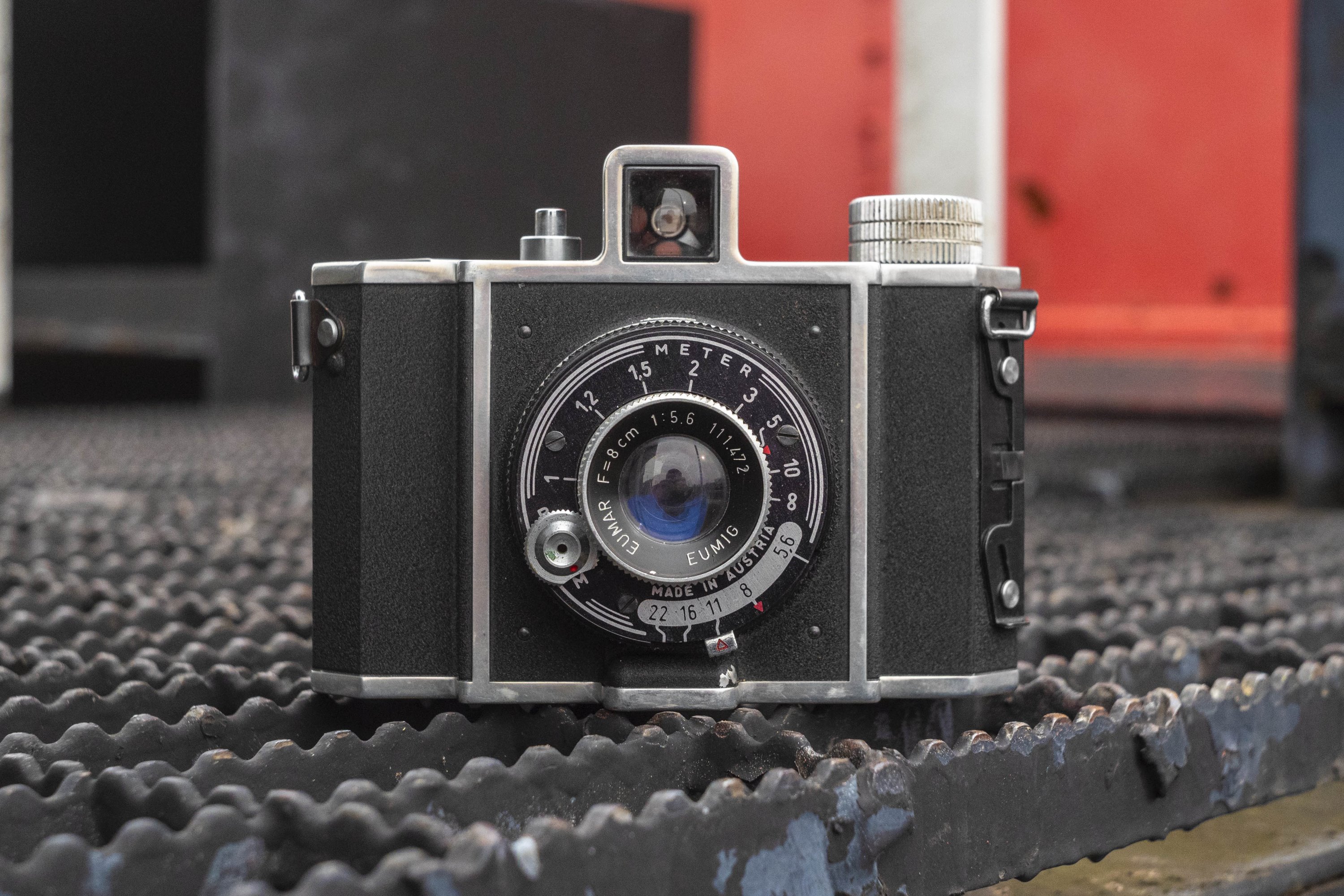
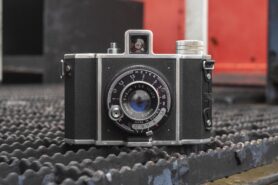
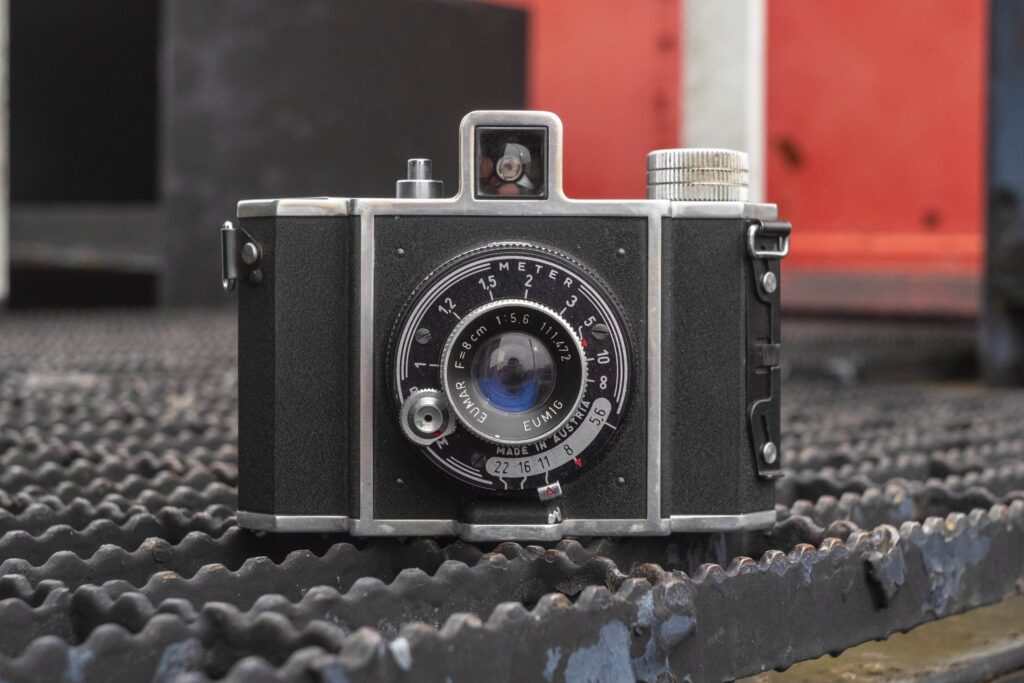












Wow, the results are much better than I expected. That must be a pretty decent lens.
I love the small and relatively basic documentary image making machines of this era – a lot of resolution and detail to render a scene.
Not made for shallow DOF or quick snapshots unless the light is bright enough to use f11 at least, but great to put on a tripod for landscapey and night time stuff, and – this is what I really love the most – usually reliable due to being devoid of extra internal machinery that can stop a more complex camera of the same vintage in it’s tracks.
I’ve had two expensive and otherwise great condition Super Ikontas bricked within a roll or two due to their finicky film transport mechs coming apart, while my little Voigtlander Perkeo and Zeiss Nettar folders with their rudimentary manual film winders are going strong.
Thanks for these reviews, they put a bunch of cameras on my radar that otherwise I’d have no idea about!